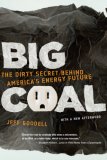Summary | Excerpt | Reading Guide | Reviews | Beyond the Book | Readalikes | Genres & Themes | Author Bio

Critics' Opinion:
Readers' Opinion:
First Published:
Jun 2006, 352 pages
Paperback:
Apr 2007, 352 pages
 Book Reviewed by:
Book Reviewed by:
BookBrowse Review Team
Buy This Book
I didn’t know that. Later, I would find out that his calculations were
wildly exaggerated. But his larger point about the interconnectedness of the
dirty life of the mines and the sparkly pixels on my computer screen was
correct. What Raney was really saying to me, I understood later, was this:
You use a computer. You have lights in your house. You watch TV. You are
implicated in all of this.
We all are.
I spent three years researching and writing this book. I visited coal mines and
power plants in ten states, as well as in China. I rode coal trains across the
Great Plains, detonated 55,000 pounds of explosives in Wyoming, and spent
a month on a research vessel in the North Atlantic with scientists who were
studying climate change. As it turned out, the three years I spent on this
book were three of the four hottest years on record. When I started my
research, an energy industry consultant joked with me that a ferocious
hurricane would have to wipe out New Orleans before America would wake up
to the dangers of global warming. By the time I finished the book, that
hurricane had arrived, although the awakening had not.
During those three years, about 3 billion tons of coal went up in
smoke in America. They created light and heat for much of the nation (not to
mention the glow on my computer screen even now as I write). But during
those years, the American Lung Association calculates, about 72,000 people
in the United States died prematurely from the effects of coal-fired power
plant pollution—more than from AIDS, murder, or drug overdose.
Obviously, there’s no free power lunch: nukes can melt down,
dams flood valleys, and wind turbines kill birds. Building the modern world is
fraught with tradeoffs. But unlike in China or India, it’s hard to argue that by
burning coal to create electricity, America is lifting millions out of poverty and
introducing them to hot showers and cold Cokes. Our affection for coal is
essentially an old habit and an indulgence. At best, it’s a short-term solution
to a long-term problem. And the price of this indulgence may be higher than
any economist can calculate. Wally Broecker, the great climatologist at
Columbia University’s Lamont-Doherty Earth Observatory, has compared the
earth’s climate to a dragon: when you poke it, you can never be sure how it’s
going to react. As Broecker says, “We’re playing with the whole planet,
dammit, just to get energy for a few hundred years.”
Working on this book, I came to understand that when we talk
about energy, what we are really talking about is how we live and what we
value. Are we willing to put the earth’s climate at risk to save ten bucks on
our utility bills? To what degree do we want energy corporations to control our
access to power? Is it more important to protect yesterday’s jobs or to create
a new industry for tomorrow? What degree of sacrifice are we willing to make
in our lifestyles to ensure the well-being of our children and grandchildren?
The coal industry, of course, would rather keep the conversation focused on
the price of electricity per kilowatt-hour and the stockholders’ return on
investment. Coal is a commodity business, after all, one that is run mostly
by number crunchers who see the world as a spreadsheet to conquer.
Questions about the price of progress, and how we draw the line between
what is acceptable to us as a rich, modern society and what is not, do not fit
easily into these calculations.
This problem is as old as our love affair with coal. In 1893, the
Chicago World’s Fair gave many Americans their first view of the miraculous
dynamos that turned coal into clean, bright incandescent light. Among the
fair’s 23 million visitors was Henry Adams, a well-traveled writer and historian
from a prominent Massachusetts family. (His grandfather and great-
grandfather were both presidents, and his brother ran the Union Pacific
railroad.) For Adams, the sight of the coal-fired dynamos was a sign that
American life was about to change irrevocably. He felt the forty-foot dynamos
as a moral force, much as the early Christians felt the Cross. And it
frightened him. As Adams put it, “Chicago asked in 1893 for the first time the
question whether the American people knew where they were driving.”
Copyright © 2006 by Jeff Goodell. Reprinted with permission by Houghton Mifflin Company.





The Flower Sisters
by Michelle Collins Anderson
From the new Fannie Flagg of the Ozarks, a richly-woven story of family, forgiveness, and reinvention.

The House on Biscayne Bay
by Chanel Cleeton
As death stalks a gothic mansion in Miami, the lives of two women intertwine as the past and present collide.

The Funeral Cryer by Wenyan Lu
Debut novelist Wenyan Lu brings us this witty yet profound story about one woman's midlife reawakening in contemporary rural China.
Your guide toexceptional books
BookBrowse seeks out and recommends the best in contemporary fiction and nonfiction—books that not only engage and entertain but also deepen our understanding of ourselves and the world around us.